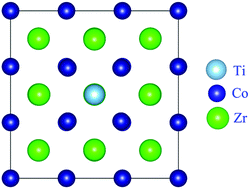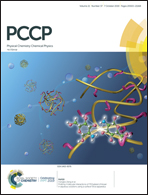Effect of doping Ti on the vacancy trapping mechanism for helium in ZrCo from first principles†
Abstract
The interactions of dopants with point defects such as that between vacancies and helium can affect helium evolution and ultimately the macroscopic properties of materials. Herein, the microscopic vacancy trapping mechanism for He defects and the formation of small HemVacn (consisting of m He atoms and n vacancies) clusters in pure and Ti-doped ZrCo systems are investigated by carrying out an extensive set of first-principles calculations based on density functional theory. Our results uncover the following: the helium atom can segregate from the adjacent interstitial (tetrahedral and octahedral) sites towards the vacancy center spontaneously, and therefore, a single He atom is energetically favorable to occupy a vacancy whether in the pure or in the doped system. The dopant Ti can act as a trapping center for He impurities similar to a vacancy. Moreover, it can improve the trapping ability and increase the trapping radius of the vacancies for helium. As for the effect of the Ti atom on the trapping of multiple helium atoms by the vacancy, the higher barrier in the doped systems than in the pure one implies that doping inhibits the formation of large HemVac clusters. Furthermore, in order to evaluate the effect of dopant Ti on the stability of He atoms in multiple vacancies, the binding energies of a helium atom, a vacancy (Vac), and a self-interstitial atom (SIA) to a helium–vacancy cluster (HemVacn) were obtained and compared with that of the pure system. The results suggest that the cluster growth can be inhibited by the dopant Ti, and therefore, the formation of large helium bubbles is also hindered. All the binding energies do not depend much on the cluster size but primarily on the helium-to-vacancy ratio (m/n) of the clusters. The stability of the clusters is decided by the competitive processes among the emission of He atoms, vacancies, and SIAs, and also depends on the helium-to-vacancy ratio. The present results provide an in-depth explanation for the effect of the dopant on helium behavior and could aid future tritium storage material design.



 Please wait while we load your content...
Please wait while we load your content...